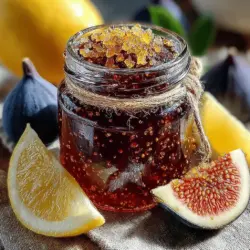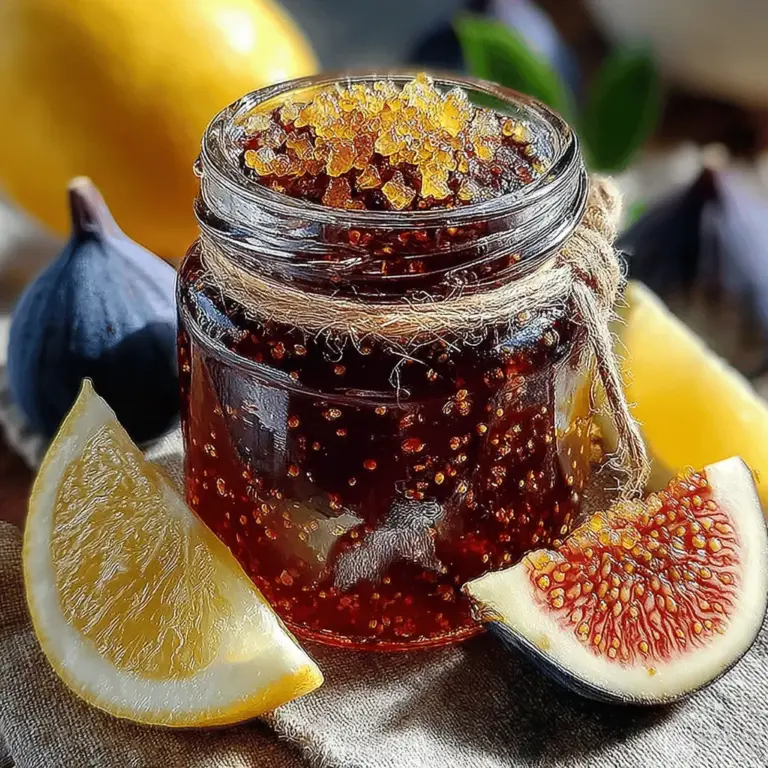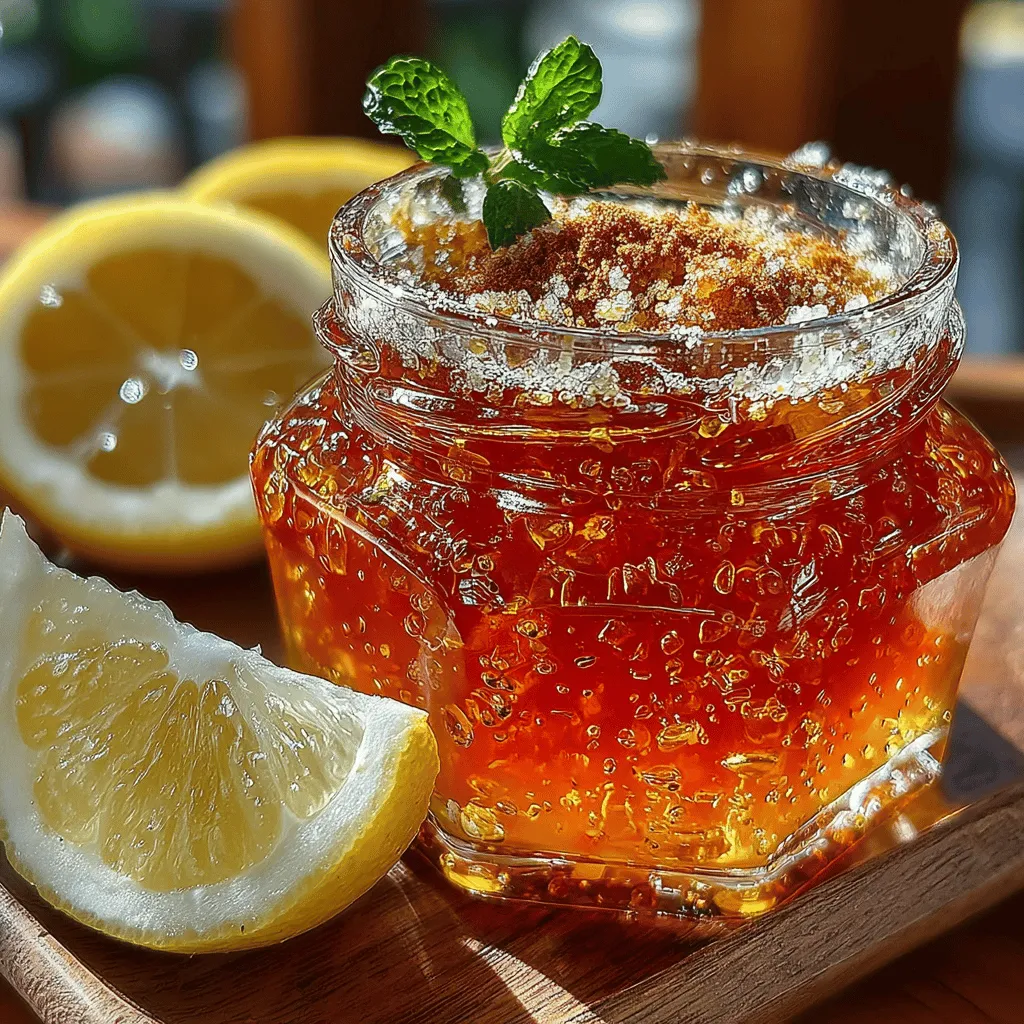Sweet & Simple Fig Jam: A Delicious Homemade Delight
Fig jam, with its luscious texture and sweet, nuanced flavors, is a delightful treat that has captured the hearts and palates of many. This charming preserve, made from ripe figs, offers a unique balance of sweetness and subtle earthiness that is hard to resist. Whether slathered on warm toast, dolloped atop a creamy cheese platter, or used as a flavorful filling for pastries, fig jam is a versatile ingredient that can elevate a multitude of dishes. The best part? Making your own fig jam at home is both simple and rewarding, allowing you to enjoy the fresh taste of figs in a jar.
In this article, we’ll dive into the fascinating world of figs and show you how to create your very own Sweet & Simple Fig Jam. Not only will we discuss the appeal of this delightful preserve, but we will also explore the essential ingredients and provide you with step-by-step instructions to guide you through the process.
Understanding Figs: Nature’s Sweet Gems
Figs are not just delicious; they are also packed with nutritional benefits. Rich in dietary fiber, vitamins, and minerals, figs are known to support digestive health and provide a quick source of energy. Their sweet, honey-like flavor profile, combined with a chewy texture, makes them a unique fruit that stands out in both sweet and savory dishes.
Historically, figs have been cultivated for thousands of years, dating back to ancient civilizations such as the Egyptians and Greeks. They have been revered not only for their taste but also for their medicinal properties. In various cuisines around the globe, figs are used in a multitude of ways—from fresh salads and savory dishes to desserts and preserves. This adaptability makes figs a cherished ingredient in many culinary traditions.
When it comes to seasonal availability, fresh figs typically peak during late summer to early autumn. Their short growing season means that they are often best enjoyed fresh, but making fig jam is an excellent way to preserve their flavor and enjoy them year-round.
Ingredients Breakdown: The Essentials for Fig Jam
Creating Sweet & Simple Fig Jam requires just a few key ingredients, each playing a vital role in the final flavor and texture of the preserve.
1. Fresh Figs: The star of the show, ripe figs are crucial for a successful jam. When selecting figs, look for those that are plump, slightly soft to the touch, and free from blemishes. The sweetness of the figs will significantly influence the overall taste of your jam, so choosing high-quality fruit is essential.
2. Granulated Sugar: Sugar not only sweetens the jam but also acts as a preservative, helping to extend its shelf life. The amount of sugar can be adjusted based on the natural sweetness of the figs or personal preference, but it is important to maintain a balance to ensure the jam sets properly.
3. Fresh Lemon Juice: The acidity of lemon juice is key in balancing the sweetness of the figs. It also enhances the preservation of the jam, preventing it from spoiling too quickly. Freshly squeezed lemon juice is recommended, as it provides a brighter flavor compared to bottled varieties.
4. Optional Ingredients: While the basic fig jam recipe is delicious on its own, adding a splash of vanilla extract or a sprinkle of ground cinnamon can elevate the flavor profile. These ingredients introduce warm, aromatic notes that complement the figs beautifully.
5. Sea Salt: A pinch of sea salt is often overlooked but is crucial for enhancing the overall flavors of the jam. It helps to balance the sweetness and brings out the natural taste of the figs.
Step-by-Step Instructions: Preparing the Figs
Now that we have a good understanding of the ingredients, let’s move on to the preparation process. Making fig jam is straightforward, but attention to detail will yield the best results.
1. Washing the Figs: Begin by gently rinsing the fresh figs under cool running water. This step is important to remove any dirt or residue from the skin. After washing, pat the figs dry with a clean towel.
2. Quartering the Figs: Next, prepare the figs for cooking by removing the stems and quartering them. This can be done by slicing each fig into quarters, which will help them break down more easily during the cooking process.
3. Mashing for Texture: Depending on your texture preference, you can either mash the quartered figs with a fork or potato masher to achieve a chunky consistency or leave them in larger pieces for a more rustic jam. Mashing the figs will also help release their natural juices, which is essential for creating a smooth jam.
4. Mixing the Ingredients: Once the figs are prepared, transfer them to a large pot. Add the granulated sugar, fresh lemon juice, and a pinch of sea salt to the pot. If you’re using optional ingredients like vanilla extract or ground cinnamon, this is the time to incorporate them. Stir the mixture gently to combine all the ingredients, ensuring that the sugar begins to dissolve.
With the figs prepared and the ingredients mixed, you are now ready to move on to the cooking process, where the magic of transforming fresh figs into a delightful jam will take place. Stay tuned for the next part, where we will cover the cooking steps and how to achieve that perfect jam consistency.
Tips for Ensuring Even Distribution of Sugar and Other Ingredients
When making fig jam, it’s crucial to ensure that sugar and other ingredients are evenly distributed throughout the mixture. Begin by cutting the figs into uniform pieces. This will help them cook evenly and integrate well with the sugar. After chopping, sprinkle the sugar evenly over the figs and allow them to sit for about 30 minutes. This resting period allows the figs to release their natural juices, creating a syrup that will help dissolve the sugar more evenly.
Stir gently but thoroughly to combine the figs with the sugar before cooking. Use a wooden spoon or a silicone spatula to prevent any stickiness from the sugar. This is especially important since uneven sugar distribution can lead to areas that may burn during cooking, affecting the overall flavor and texture of your jam.
Importance of Stirring to Prevent Burning
Stirring is a critical step in the cooking process of your fig jam. As the mixture heats, the sugar will start to dissolve, and the figs will soften and release more juice. Continuous stirring ensures that all ingredients are well combined and prevents them from sticking to the bottom of the pot, which can lead to burning.
Use a gentle but firm motion to stir the mixture, scraping the corners and bottom of the pot. This action will help release any bits that might cling to the bottom, allowing for a more even cooking process. If you notice any sticking, reduce the heat slightly to ensure that the mixture cooks without scorching.
Cooking the Mixture
Ideal Temperature and Duration for Achieving the Right Consistency
Once you have stirred the fig and sugar mixture together, it’s time to cook it. Place your pot over medium heat and bring the mixture to a gentle simmer. The goal is to cook the jam slowly, allowing the figs to break down and the flavors to meld beautifully.
Cook the mixture for about 30 to 40 minutes, stirring frequently. As it cooks, the mixture will start to thicken. You want to monitor the temperature, ideally keeping it around 220°F (104°C) for optimal jam consistency.
Visual and Textural Cues for Determining Doneness
Determining when your fig jam is done requires both visual and textural cues. As the mixture thickens, you will notice that it becomes less soupy and starts to coat the back of your spoon. A classic test for jam doneness is the “plate test.” To perform this test, place a small plate in the freezer for a few minutes. After that, drop a teaspoon of the jam onto the cold plate and return it to the freezer for about 30 seconds. Run your finger through the jam; if it holds its shape and the line stays clear, your jam is ready.
Another visual cue is the color change. The jam will deepen in color as it cooks, becoming richer and more vibrant. Pay attention to these signs to achieve the perfect texture and flavor.
Cooling and Storing
Best Practices for Transferring Jam into Jars
Once your fig jam has reached the desired consistency, it’s time to transfer it into jars. Start by preparing your canning jars and lids. Ensure they are clean and sterilized to prevent contamination. You can sterilize jars by boiling them in water for 10 minutes or placing them in a preheated oven at 200°F (93°C) for 15 minutes.
Using a funnel will help minimize mess during the transfer. Carefully ladle the hot jam into the jars, leaving about 1/4 inch of headspace at the top. This space is crucial because it allows for expansion during processing and prevents overflow during sealing.
Explanation of Headspace and Its Relevance in Preservation
Headspace refers to the empty space between the lid of the jar and the top of the jam. It plays a vital role in the preservation process. Insufficient headspace can lead to pressure buildup, causing the lid to pop or the jar to break. Conversely, too much headspace may allow air to enter, which can spoil the jam over time.
After filling the jars, wipe the rims with a clean, damp cloth to remove any residue that might prevent a proper seal. Place the sterilized lids on the jars and screw on the metal bands until they are fingertip-tight.
Tips for Refrigeration and Longer Storage Options
If you plan to consume your fig jam within a few weeks, simply let the jars cool to room temperature before placing them in the refrigerator. Homemade fig jam can last for several weeks in the fridge.
For longer storage, consider water bath canning. This method involves submerging the sealed jars in boiling water for about 10 minutes. This process creates a vacuum seal, extending the shelf life of your jam for up to a year when stored in a cool, dark place. Always check for signs of spoilage before consuming any preserved food.
Exploring the Uses of Fig Jam
Ideas for Pairing Fig Jam with Cheeses, Meats, and Breads
Fig jam is a versatile ingredient that can elevate a variety of dishes. It pairs beautifully with a range of cheeses, particularly creamy varieties like goat cheese, brie, or blue cheese. Spread it on a cheese board alongside crackers and fresh fruit for an elegant appetizer.
Moreover, fig jam complements savory meats such as prosciutto or roasted pork. The sweetness of the jam balances the saltiness of the meats, creating a delightful contrast. For a quick and delightful sandwich, slather fig jam on crusty bread with thinly sliced meats and cheese.
Creative Uses in Desserts or as a Topping for Breakfast Items
In the realm of desserts, fig jam can be used as a filling for pastries or thumbprint cookies. It can also be swirled into yogurt or oatmeal for a touch of sweetness at breakfast. For those who love pancakes or waffles, a dollop of fig jam can serve as a delicious alternative to maple syrup, adding depth of flavor and a touch of sophistication to your morning meal.
Suggestions for Incorporating Fig Jam into Savory Dishes
Don’t hesitate to think outside the box! Fig jam can also enhance savory dishes, like glazes for roasted vegetables or meats. A spoonful can be added to sauces to deepen their flavor profile. Try mixing it into a salad dressing for a sweet twist that pairs well with peppery greens or roasted nuts.
Nutritional Information
Overview of the Health Benefits of Figs and Jam Consumption
Figs are not only delicious but also packed with nutrients. They are an excellent source of dietary fiber, antioxidants, and essential minerals such as calcium, magnesium, and potassium. Regular consumption of figs can promote digestive health, support bone density, and contribute to heart health due to their fiber and antioxidant content.
While fig jam does contain sugar, the natural sugars from figs are complemented by the fiber content, making it a healthier option compared to many processed jams. However, moderation is key, especially for those monitoring their sugar intake.
Discussion on Moderation and Serving Sizes
When enjoying fig jam, it’s important to consider serving sizes. A typical serving is about one tablespoon, which can add a burst of flavor without overwhelming your diet with sugar. Pairing it with other nutritious foods, like whole grain bread or yogurt, can help balance the meal and enhance its health benefits.
Considerations for Dietary Restrictions and Substitutions
For those with dietary restrictions, it’s worth noting that fig jam can be made with alternative sweeteners like honey or agave syrup, or even without added sugar if the figs are ripe enough. Always check for potential allergens in commercial versions, as some may contain preservatives or additives. Homemade fig jam allows for complete control over the ingredients, making it a great option for those with specific dietary needs.
Conclusion
Making homemade fig jam is not just a culinary project; it’s a celebration of seasonal fruits and the joy of preserving their flavors. Whether enjoyed on a slice of toast, paired with cheese, or as a recipe ingredient, the satisfaction that comes from creating your own jam is unparalleled.
Feel free to experiment with different spices like cinnamon or vanilla, or incorporate other fruits for added complexity. Each batch can reflect your personal taste, so don’t hesitate to make it uniquely yours.
In sharing your homemade fig jam with friends and family, you’re not only offering them a delicious treat but also a piece of your culinary creativity. So gather those figs while they’re in season, and dive into the sweet and simple pleasure of making fig jam!


